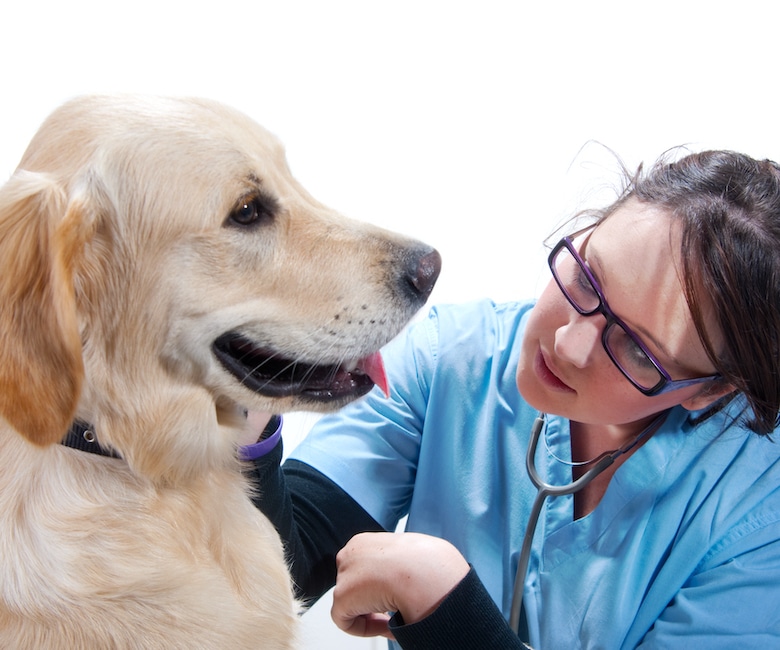How to Make Your Dog’s Vet Visit Less Scary

Even though I’m a dog trainer, my dog, like many dogs, doesn’t especially like going to the vet. When she was a puppy, I worked hard to make the vet a fun place for her, but she’s sensitive, and after she had knee surgery, we had to work hard to get her back to feeling confident and comfortable at the vet. Then the pandemic hit. Our vet clinics, like most across the country, have transitioned to curbside drop-offs. This makes utilizing our usual fear-free protocols almost impossible. Luckily, there are things we can do to make our dog’s vet visits less scary.
Plan ahead when taking your dog to the vet
Whenever possible, plan ahead, keep your dog updated on vaccines and wellness visits. This will help you stay ahead of any potential issues. Having a regular vet clinic that knows you and knows your dog also makes it much more likely that they’ll be able to squeeze you in for an appointment in the case of an emergency.
Help make your dog’s vet visit less scary through positive associations
Whenever possible (and this used to be possible but has become less probable depending on the level of lockdown your community is experiencing), make casual trips to the vet clinic when you don’t have an appointment. Most vet clinics are very amenable to these informal hello visits and welcome people to come and train their dogs at the clinics. While at the office, give your dog a treat, allow the receptionists or techs to give your dog treats, and go. Making the vet clinic fun and a regular place to visit reduces the stress associated with being in the clinic.
Use technology to your advantage
Practice skills that your dog will need in the vet clinic at home, like rewarding your dog for calmly standing for exams and make sure you talk directly to your vet clinic about the training you are doing and how the clinic can be supportive.
Laura Monaco Torelli, who recently hosted the workshop “Husbandry at Home for Real-World Applications,” suggests dog guardians send videos of their training sessions to your vet in advance. This way, they know how you are working with your dog to prepare for visits. The vet clinic staff using the same cues and techniques will help your dog feel more confident and comfortable during the visit. Using technology to your advantage can help your dog get better and faster vet care.
Also, most clinics will be happy for you to email videos in advance of your visit if there are concerns or symptoms that you are struggling to describe or something that your vet should see but would be hard to replicate at a clinic.
Advocate for your dog
You are your dog’s best advocate to make sure their physical and emotional needs are met and that they are safe and comfortable, and that includes when going to the vet. Although your vet might be an expert on your dog’s health, you are the expert on your dog’s emotional well-being. Instead of just handing off your dog to the technician at the curb, you can take charge of the appointment and explain to the vet technician exactly how your dog needs to be handled/treated during the visit. Are there things that make your dog nervous or uncomfortable? Things that help your dog to feel more relaxed? It’s always appropriate to communicate any of those things to your vet and staff of the clinic.
Have an info sheet for your dog
One of the most frustrating things (though understandable) about the pandemic is knowing that my dog must go into vet appointments alone and that she can’t express clearly to our vet what is going on, what hurts or how they are feeling. Something that I have found especially useful with vet visits during the pandemic is to help my pets “talk” to the vet by handing the technician who comes outside to get my pet a personalized info sheet.
At the top of the info sheet, I put a picture of my dog, my dog’s name, followed by basic information like age, the type of food we feed, and any supplements and medication, including monthly flea/tick and heartworm preventatives.
The technician will likely ask you for this information, but having it “attached” to your dog as they are seen can help prevent errors or miscommunication. I also include any data I want to make sure they remember, like that my dog has had both of her knees surgically reconstructed and that she’s nervous about being at the clinic.
Avoid writing an essay; instead, use bullet points to highlight any concerns you have so your vet can see them immediately. This also gives you a chance to compose your thoughts ahead of time to make sure you don’t forget anything when you talk to the vet, especially since you won’t be in the exam room with your dog.
Staying calm will make your dog’s vet visit less scary
Our dogs are incredibly responsive to us, often feeding off our emotions. If we are upset or concerned about having to pass our dog off to vet staff at the curb, our dogs may feed on that anxiety. Try to remain calm and confident. Not only will this help your dog to have a better vet experience, but it will also help the visits to be less stressful for both of you.
Featured Image: MartinPrescott/Getty Images
Read Next: These Vets Make House Calls
